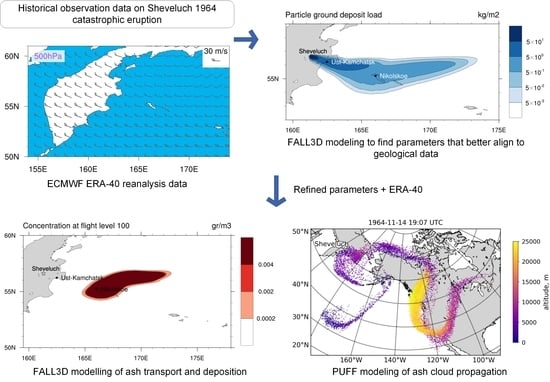Numerical Modeling of the Ash Cloud Movement from the Catastrophic Eruption of the Sheveluch Volcano in November 1964
Abstract
:1. Introduction
2. The Sheveluch Volcano
3. The Catastrophic Eruption of Sheveluch in 1964
3.1. Seismic and Acoustic Data
3.2. Visual Data on the Eruptive Cloud
3.3. Tephra Deposits and Geological Results of the Catastrophic Eruption
4. Materials and Methods
4.1. Weather Data
4.2. Mathematical and Algorithmic Support
4.3. The Recovery of Explosive Eruption Parameters
- bi-lognormal distribution parameters for the total grain-size distribution of the ash (μ and σ in Φ-units): (Figure 7);
- Suzuki distribution parameters: A = 4, λ = 1.5;
- the mass flow rate: 1.7 × 108 kg/s.
5. Results
5.1. Ash Cloud Propagation
5.2. Ashfall Deposits
5.3. Aerosol Ash Clouds
5.4. Aviation Hazard
6. Discussion
- At 19:07 UTC, 11 November, the high-temperature juvenile materials rushed to the earth’s surface, causing the destruction of extrusive domes in the northern part of the crater by powerful explosions directed to the southwest (directed blast eruption) [32].
- The material of the destroyed extrusive domes then formed directed blast deposits, shaped like a wide fan, on the southern slope of Sheveluch [32].
- The high-temperature juvenile substance (its content in the tephra deposits reaches 95% [29]) then began egress through the open conduit and formed an eruptive column reaching an altitude of 15,000 m a.s.l. This process was accompanied by volcanic tremor lasting from 19:20 to 20:22 UTC, 11 November [32].
- The tropopause altitude above Kamchatka typically varies from 8000–11,000 m a.s.l. throughout the year [6]. The eruptive column rose above the tropopause and transformed into a mushroom-like cloud that featured numerous lightning bolts. This cloud started to move east-southeast of the volcano.
- Simultaneously, from the edge regions of the eruptive column, large volumes of pyroclastic material collapsed and moved in the form of pyroclastic flows along the central part of the southern volcanic slope (the pyroclastic flow deposits situated on the directed blast deposits) [32]).
- A co-ignimbrite cloud then formed above the moving pyroclastic flows, in which ash and sand particles, as well as small rock fragments, were curling and intermixing. This cloud was too heavy (“lead-colored” [51] (p. 30)) and only reached an altitude of 6000–12,000 m a.s.l. Due to a different wind direction in the lower layers of the atmosphere, the co-ignimbrite cloud moved south-southeast of the volcano, unlike the main eruptive cloud.
- In Nikolskoye, ash fell only from the co-ignimbrite cloud. The trajectory of the main eruptive cloud was north of the Commander Islands (Figure 9a).
- The overall area of both land and sea experiencing ashfalls between 19:07 UTC, November 11 and 07:07 UTC, 12 November, is estimated to have been 147,686 km2 (Figure 16), including 10,200 km2 on land (in Kamchatka, the Bering Island and the Medny Island). The use of the FALL3D model refined the data for the area of ashfalls we obtained earlier in the experiment [37].
- Due to the turbulent diffusion, the head of the main eruptive cloud lifted slowly through the atmosphere. By 21:37 UTC, November 11, it reached 16,000 m a.s.l., and by 04:07 UTC, 12 November, it reached 16,500 m a.s.l. Twenty-four hours after the eruption began, the eruptive cloud, at an altitude of up to 16,800 m a.s.l., reached Alaska. By three days after the eruption, the ash cloud stretched for 3000 km and covered the territories of Russia, Canada, USA, and Mexico, as well as the Bering Sea and the Pacific Ocean. It is possible that the ash clouds from the Sheveluch volcano posed a danger to aviation in these areas within 3–5 days after the end of the eruption.
7. Conclusions
Author Contributions
Funding
Data Availability Statement
Acknowledgments
Conflicts of Interest
References
- Miller, T.P.; Casadevall, T.J. Volcanic ash hazards to aviation. In Encyclopedia of Volcanoes; Sigurdsson, H., Ed.; Academic Press: London, UK; San Diego, CA, USA, 2000; pp. 915–930. [Google Scholar]
- Prata, A.; Rose, W. Volcanic ash hazard to aviation. In Encyclopedia of Volcanoes, 2nd ed.; Sigurdsson, H., Houghton, B., McNutt, S., Rymer, H., Stix, J., Eds.; Academic Press: London, UK; San Diego, CA, USA; Waltham, MA, USA, 2015; pp. 911–934. [Google Scholar]
- Lechner, P.; Tupper, A.; Guffanti, M.; Loughlin, S.; Casadevall, T. Volcanic Ash and Aviation—The Challenges of Real-Time, Global Communication of a Natural Hazard. In Observing the Volcano World. Advances in Volcanology; Fearnley, C.J., Bird, D.K., Haynes, K., McGuire, W.J., Jolly, G., Eds.; Springer: Cham, Switzerland, 2017; pp. 51–64. [Google Scholar] [CrossRef] [Green Version]
- Igarashi, Y.; Girina, O.A.; Osiensky, J.; Moore, D. International Coordination in Managing Airborne Ash Hazards: Lessons from the Northern Pacific. In Observing the Volcano World. Advances in Volcanology; Fearnley, C.J., Bird, D.K., Haynes, K., McGuire, W.J., Jolly, G., Eds.; Springer: Cham, Switzerland, 2017; pp. 529–547. [Google Scholar] [CrossRef] [Green Version]
- Gordeev, E.I.; Girina, O.A. Volcanoes and Their Hazard to Aviation. Her. Russ. Acad. Sci. 2014, 84, 134–142. [Google Scholar] [CrossRef] [Green Version]
- Kirianov, V.Y. Assessment of Kamchatkan Ash Hazard to Airlines. Volcanol. Seismol. 1993, 14, 246–269. [Google Scholar]
- Kirianov, V.Y. Volcanic ash in Kamchatka as a Source of Potential Hazard to Air Traffic. In Volcanic Ash and Aviation Safety: Proc. First Int. Symp. Volcanic Ash and Aviation Safety; Casadevall, T.J., Ed.; United States Government Printing Office: Washington, WA, USA, 1994; pp. 57–64. [Google Scholar] [CrossRef]
- Guffanti, M.; Miller, T.P. A Volcanic Activity Alert-Level System for Aviation—Review of its Development and Application in Alaska. Nat. Hazards 2013, 69, 1519–1533. [Google Scholar] [CrossRef]
- Neal, C.A.; Girina, O.A.; Senyukov, S.L.; Rybin, A.V.; Osiensky, J.; Izbekov, P.; Ferguson, G. Russian Eruption Warning Systems for Aviation. Nat. Hazards 2009, 51, 245–262. [Google Scholar] [CrossRef] [Green Version]
- Braitseva, O.A.; Bazanova, L.I.; Melekestsev, I.V.; Sulerzhitsky, L.D. Largest Holocene eruptions of Avachinsky volcano, Kamchatka. Volcanol. Seismol. 1998, 20, 1–27. [Google Scholar]
- Girina, O.A.; Loupian, E.A.; Sorokin, A.A.; Melnikov, D.V.; Manevich, A.G.; Manevich, T.M. Satellite and Ground-Based Observations of Explosive Eruptions on Zhupanovsky Volcano, Kamchatka, Russia in 2013 and in 2014–2016. J. Volcanolog. Seismol. 2018, 12, 1–15. [Google Scholar] [CrossRef] [Green Version]
- Girina, O.A.; Melnikov, D.V.; Manevich, A.G.; Loupian, E.A.; Kramareva, L.S. The Characteristics of Bezymianny Volcano Explosive Eruption Events on March 15, 2019, Inferred from Satellite Data. Sovrem. Probl. Distantsionnogo Zondirovaniya Zemli Kosm. 2020, 17, 102–114. [Google Scholar] [CrossRef]
- Koyaguchi, T.; Ohno, M. Reconstruction of Eruption Column Dynamics on the Basis of Grain Size of Tephra Fall Deposits: 2. Application to the Pinatubo 1991 Eruption. J. Geoph. Res. 2001, 106, 6513–6534. [Google Scholar] [CrossRef]
- Myers, M.L.; Druitt, T.H.; Schiavi, F.; Gurioli, L.; Flaherty, T. Evolution of Magma Decompression and Discharge During a Plinian Event (Late Bronze-Age eruption, Santorini) from Multiple Eruption-Intensity Proxies. Bull. Volcanol. 2021, 83, 18. [Google Scholar] [CrossRef]
- Sigurdsson, H.; Carey, S. Plinian and Co-Ignimbrite Tephra Fall from the 1815 Eruption of Tambora Volcano. Bull. Volcanol. 1989, 51, 243–270. [Google Scholar] [CrossRef]
- Sigurdsson, H.; Cashdollar, S.; Sparks, R.S.J. The eruption of Vesuvius in A. D. 79: Reconstruction from Historical and Volcanological Evidence. Am. J. Archeol. 1982, 86, 39–51. [Google Scholar] [CrossRef] [Green Version]
- Simkin, T.; Fiske, R. Krakatau 1883: The Volcanic Eruption and Its Effects; Smithsonian Institute Press: Washington, WA, USA, 1983; 464p. [Google Scholar]
- Michon, L.; Di Muro, A.; Villeneuve, N.; Saint-Marc, C.; Fadda, P.; Manta, F. Explosive Activity of the Summit Cone of Piton de la Fournaise volcano (La Réunion island): A historical and geological review. J. Volcanol. Geotherm. Res. 2013, 263, 117–133. [Google Scholar] [CrossRef] [Green Version]
- Uppala, S.M.; KÅllberg, P.W.; Simmons, A.J.; Andrae, U.; Da Costa Bechtold, V.; Fiorino, M.; Gibson, J.K.; Haseler, J.; Hernandez, A.; Kelly, G.A.; et al. The Era-40 Re-analysis. Q. J. R. Meteor. Soc. 2005, 131, 2961–3012. [Google Scholar] [CrossRef]
- Kanamitsu, M.; Ebisuzaki, W.; Woollen, J.; Shi-Kend, Y.; Hnilo, J.J.; Fiorino, M.; Potter, G.L. NCEP-DOE AMIP-II Reanalysis (R-2). Bull. Amer. Meteorol. Soc. 2002, 83, 1631–1644. [Google Scholar] [CrossRef]
- Carey, S.N.; Sigurdsson, H. The 1982 Eruptions of El Chichón Volcano, Mexico (2): Observations and Numerical Modeling of Tephra-Fall Distribution. Bull. Volcanol. 1986, 48, 127–141. [Google Scholar] [CrossRef]
- Costa, A.; Macedonio, G.; Folch, A. A Three-Dimensional Eulerian Model for Transport and Deposition of Volcanic Ashes. Earth Planet. Sci. Lett. 2006, 241, 634–647. [Google Scholar] [CrossRef]
- Costa, A.; Folch, A.; Macedonio, G. Density-Driven Transport in the Umbrella Region of Volcanic Clouds: Implications for Tephra Dispersion Models. Geophys. Res. Lett. 2013, 40, 4823–4827. [Google Scholar] [CrossRef]
- Costa, A.; Pioli, L.; Bonadonna, C. Assessing Tephra Total Grain-Size Distribution: Insights from Field Data Analysis. Earth Planet. Sci. Lett. 2016, 443, 90–107. [Google Scholar] [CrossRef]
- Mastin, L.G.; Guffanti, M.; Servranckx, R.; Webley, P.; Barsotti, S.; Dean, K.; Durant, A.; Ewert, J.W.; Neri, A.; Rose, W.I.; et al. A Multidisciplinary Effort to Assign Realistic Source Parameters to Models of Volcanic Ash-Cloud Transport and dispersion During Eruptions. J. Volcanol. Geotherm. Res. 2009, 186, 10–21. [Google Scholar] [CrossRef]
- Pfeiffer, T.; Costa, A.; Macedonio, G. A Model for the Numerical Simulation of Tephra Fall Deposits. J. Volcanol. Geotherm. Res. 2005, 140, 273–294. [Google Scholar] [CrossRef]
- Webley, P.W.; Dean, K.; Dehn, J.; Bailey, J.E.; Peterson, R. Volcanic-ash Dispersion Modeling of the 2006 Eruption of Augustine Volcano using the Puff model. In The 2006 Eruption of Augustine Volcano, Alaska; Power, J.A., Coombs, M.L., Freymueller, J.T., Eds.; U.S. Geological Survey: Reston, VA, USA, 2010; pp. 507–526. [Google Scholar] [CrossRef]
- Belousov, A.B. The Shiveluch volcano eruption of 12 November 1964—Explosive eruption provoked by failure of the edifice. J. Volcanol. Geotherm. Res. 1995, 66, 357–365. [Google Scholar] [CrossRef] [Green Version]
- Bogoyavlenskaya, G.E.; Braitseva, O.A.; Melekestsev, I.V.; Kirianov, V.Y.; Miller, C.D. Catastrophic Eruptions of the Directed-blast Type at Mount St. Helens, Bezymianny and Shiveluch Volcanoes. J. Geodynam. 1985, 3, 189–218. [Google Scholar] [CrossRef]
- Gorshkov, G.S. Gigantic Eruption of the Volcano Bezymianny. Bull. Volcanol. 1959, 20, 77–109. [Google Scholar] [CrossRef]
- Gorshkov, G.S.; Bogoyavlenskaya, G.E. Bezymianny Volcano and Peculiarities of Its Last Eruptions in 1955–1963; Piip, B.I., Ed.; Nauka: Moscow, Russia, 1965; p. 172. (In Russian) [Google Scholar]
- Gorshkov, G.S.; Doubik, Y.M. A Directed Explosion at Sheveluch volcano. In Volcanoes and Eruptions; Gorshkov, G.S., Ed.; Nauka: Moscow, Russia, 1969; pp. 3–37. (In Russian) [Google Scholar]
- Melekestsev, I.V.; Dvigalo, V.N.; Kirsanova, T.P.; Ponomareva, V.V.; Pevzner, M.M. The 300 years of Kamchatka Volcanoes: The Young Sheveluch. An Analysis of the Dynamics and Impact of Eruptive Activity During the 17–20th Centuries. Part 1. 1650–1964. Vulkanol. Seismol. 2003, 5, 3–19. (In Russian) [Google Scholar]
- Tokarev, P.I. The great Sheveluch volcano eruption of 12 November 1964 and its precursors. Izv. AN SSSR Fiz. Zemli 1967, 9, 11–22. (In Russian) [Google Scholar]
- Felitsyn, S.B.; Kiryanov, V.Y. Areal Variability of Tephra Composition as Indicated by Bulk Silicate Analysis Data. Volcanol. Seismol. 1990, 9, 1–20. [Google Scholar]
- Girina, O.A. Pyroclastic Deposits from Recent Andesitic Volcano Eruptions in Kamchatka and Their Engineering–Geological Features; Melekestsev, I.V., Ed.; Dalnauka: Vladivostok, Russia, 1998; p. 174. (In Russian) [Google Scholar]
- Girina, O.A.; Malkovsky, S.I.; Sorokin, A.A.; Loupian, E.A. The Retrospective Analysis of the 1964 Sheveluch Volcano Eruption (Kamchatka) using the VolSatView Information System. In Information Technologies in Remote Sensing of the Earth (RORSE 2018); Space Research Institute RAS: Moscow, Russia, 2019; pp. 34–41. [Google Scholar] [CrossRef]
- Girina, O.A.; Loupian, E.A.; Melnikov, D.V.; Kashnitskii, A.V.; Uvarov, I.A.; Bril, A.A.; Konstantinova, A.M.; Burtsev, M.A.; Manevich, A.G.; Gordeev, E.I.; et al. Creation and Development of the Information System Remote Monitoring of Kamchatka and Kuril Islands Volcanic Activity. Sovrem. Probl. Distantsionnogo Zondirovaniya Zemli Kosm. 2019, 16, 249–265. [Google Scholar] [CrossRef]
- Gordeev, E.I.; Girina, O.A.; Loupian, E.A.; Sorokin, A.A.; Kramareva, L.S.; Efremov, V.Y.; Kashnitskii, A.V.; Uvarov, I.A.; Burtsev, M.A.; Romanova, I.M.; et al. The VolSatView Information System for Monitoring the Volcanic Activity in Kamchatka and on the Kuril Islands. J. Volcanolog. Seismol. 2016, 10, 382–394. [Google Scholar] [CrossRef]
- Girina, O.A.; Ozerov, A.Y.; Tsvetkov, V.A.; Demyanchuk, Y.V. Squeezing out Plastic Lava Blocks on Young Shiveluch Volcano (Kamchatka) in 2020–2021. Bull. Kamchatka Reg. Assoc. Educ. Sci. Cent. Earth Scien. 2021, 51, 77–83. [Google Scholar] [CrossRef]
- Melekestsev, I.V.; Volynets, O.N.; Ermakov, V.A.; Kirsanova, T.P.; Masurenkov, Y.P. Sheveluch Volcano. In Active Volcanoes of Kamchatka; Fedotov, S.A., Masurenkov, Y.P., Eds.; Nauka: Moscow, Russia, 1991; Volume 1, pp. 98–103. [Google Scholar]
- Gorbach, N.V.; Portnyagin, M.V. Geology and Petrology of the Lava Complex of Young Shiveluch Volcano, Kamchatka. Petrology 2011, 19, 134–166. [Google Scholar] [CrossRef]
- Menyailov, A.A. Sheveluch Volcano: Its Geological Structure, Composition, and Eruptions; AS USSR: Moscow, Russia, 1955; 264p. (In Russian) [Google Scholar]
- Girina, O.A.; Demyanchuk, Y.V.; Melnikov, D.V.; Ushakov, S.V.; Ovsyannikov, A.A.; Sokorenko, A.V. The Paroxysmal Phase of the 27 February 2005 Eruption on Young Sheveluch Volcano, Kamchatka. A Preliminary Report. Vulkanol. Seismol. 2006, 1, 16–23. (In Russian) [Google Scholar]
- Ozerov, A.Y.; Girina, O.A.; Zharinov, N.A.; Belousov, A.B.; Demyanchuk, Y.V. Eruptions in the Northern Group of Volcanoes, in Kamchatka, during the Early 21st Century. J. Volcanolog. Seismol. 2020, 14, 1–17. [Google Scholar] [CrossRef]
- Gorshkov, G.S.; Bylinkina, A.A. The Observations of Sheveluch Volcano Eruption in 1948–1950. Bull. Volcanol. Stn. 1954, 20, 8–31. (In Russian) [Google Scholar]
- Kirsanov, I.T.; Kirsanova, T.P. The Volcanoes of the Northern Kamchatka in 1965. Bull. Volcanol. Station. 1970, 46, 24–25. (In Russian) [Google Scholar]
- Tokarev, P.I. The Swarm of Earthquakes at Sheveluch Volcano in May 1964. Bull. Volcanol. Station. 1964, 38, 41–44. (In Russian) [Google Scholar]
- Tokarev, P.I. Volcanic Earthquakes of Kamchatka; Resanov, I.A., Ed.; Nauka: Moscow, Russia, 1981; 164p. (In Russian) [Google Scholar]
- Gorelchik, V.I.; Shirokov, V.A.; Firstov, P.P.; Chubarova, O.S. Shiveluch Volcano: Seismicity, deep Structure and Forecasting Eruptions (Kamchatka). J. Volcanol. Geotherm. Res. 1997, 78, 121–137. [Google Scholar] [CrossRef]
- Piip, B.I.; Markhinin, E.K. The Gigantic Sheveluch Volcano Eruption on 12 November 1964. Bull. Volcanol. Stn. 1965, 39, 3–28. (In Russian) [Google Scholar]
- Rulenko, O.P.; Tokarev, P.I.; Firstov, P.P. Electricity of Volcanoes. Bull. Volcanol. Station. 1976, 52, 11–17. (In Russian) [Google Scholar]
- Kirianov, V.Y.; Egorova, I.A.; Litasova, S.N. Volcanic ash on Bering Island (Commander Islands) and Kamchatkan Holocene Eruptions. Volcanol. Seismol. 1990, 8, 850–868. [Google Scholar]
- Braitseva, O.A.; Kiryanov, V.Y.; Sulerzhitskiy, L.D. Marker Intercalations of Holocene Tephra in the Eastern Volcanic Zone of Kamchatka. Volcanol. Seismol. 1989, 7, 785–814. [Google Scholar]
- Kirianov, V.Y.; Solovieva, H.A. Lateral Variations in ash Composition due to Eolian Differentiation. Volcanol. Seismol. 1991, 12, 431–442. [Google Scholar]
- Siebert, L.; Simkin, T.; Kimberly, P. Volcanoes of the World, 3rd ed.; Smithsonian Institution: Washington, WA, USA; University California Press: Berkeley, CA, USA; Los Angeles, LA, USA; London, UK, 2010; 568p. [Google Scholar]
- Peterson, R.A. Puff UAF User’s Manual. 2003. Available online: http://web.archive.org/web/20121119195411/http://puff.images.alaska.edu/doc.shtml (accessed on 23 March 2022).
- Searcy, C.; Dean, K.; Stringer, W. PUFF: A High-Resolution Volcanic ash Tracking Model. J. Volcanol. Geotherm. Res. 1998, 80, 1–16. [Google Scholar] [CrossRef]
- Ganser, G.H. A Rational Approach to Drag Prediction of Spherical and Nonspherical Particles. Powder Technol. 1993, 77, 143–152. [Google Scholar] [CrossRef]
- Byun, D.; Schere, K.L. Review of the Governing Equations, Computational Algorithms, and Other Components of the Models-3 Community Multiscale Air Quality (CMAQ) Modeling System. Appl. Mech. Rev. 2006, 59, 51–77. [Google Scholar] [CrossRef]
- Malkovsky, S.I.; Sorokin, A.A.; Girina, O.A. Development of an Information System for Numerical Modeling of the Propagation of Volcanic ash from Kamchatka and Kuril Volcanoes. Comput. Technol. 2019, 24, 79–89. (In Russian) [Google Scholar] [CrossRef]
- Sorokin, A.A.; Girina, O.A.; Loupian, E.A.; Malkovskii, S.I.; Balashov, I.V.; Efremov, V.Y.; Kramareva, L.S.; Korolev, S.P.; Romanova, I.M.; Simonenko, E.V. Satellite Observations and Numerical Simulation Results for the Comprehensive Analysis of Ash Clouds Transport During the Explosive Eruptions of Kamchatka Volcanoes. Rus. Meteor. Hydrol. 2017, 42, 759–765. [Google Scholar] [CrossRef]
- Girina, O.A.; Melnikov, D.V.; Manevich, A.G. Satellite Monitoring of Kamchatkan and Northern Kuriles Volcanoes. Sovrem. Probl. Distantsionnogo Zondirovaniya Zemli Kosm. 2017, 14, 194–209. (In Russian) [Google Scholar] [CrossRef]
- Suzuki, T. A Theoretical Model for Dispersion of Tephra. In Arc Volcanism: Physics and Tectonics; Shimozuru, D., Yokoyama, I., Eds.; Terra Scientific Publishing Company (TERRAPUB): Tokyo, Japan, 1983; pp. 95–113. [Google Scholar]
- Takeuchi, S. Preeruptive Magma Viscosity: An Important Measure of Magma Eruptibility. J. Geoph. Res. 2011, 116, B10201. [Google Scholar] [CrossRef]
- Degruyter, W.; Bonadonna, C. Improving on Mass Flow Rate Estimates of Volcanic Eruptions. Geoph. Res. Lett. 2012, 39, L16308. [Google Scholar] [CrossRef] [Green Version]
- Woodhouse, M.J.; Hogg, A.J.; Phillips, J.C.; Sparks, R.S.J. Interaction Between Volcanic Plumes and Wind During the 2010 Eyjafjallajökull Eruption, Iceland. J. Geoph. Res. 2013, 118, 92–109. [Google Scholar] [CrossRef] [Green Version]
- Stohl, A.; Prata, A.J.; Eckhardt, S.; Clarisse, L.; Durant, A.; Henne, S.; Kristiansen, N.I.; Minikin, A.; Schumann, U.; Seibert, P.; et al. Determination of time—And Height-Resolved Volcanic Ash Emissions and Their Use for Quantitative Ash Dispersion Modeling: The 2010 Eyjafjallajökull Eruption. Atmos. Chem. Phys. 2011, 11, 4333–4351. [Google Scholar] [CrossRef] [Green Version]
- Savinov, S.I. The Highest Values of Solar Radiation Voltage According to Observations in Pavlovsk Since 1892. Izves. AS USSR. 1913, 7, 707–720. [Google Scholar]
- Kimball, H.H. Volcanic Eruption and Solar Radiation Intensity. Mon. Wea. Rev. 1918, 16, 355–356. [Google Scholar] [CrossRef]
- Dyer, A.J.; Hicks, B.B. Global Spread of Volcanic Dust from the Ball Eruption of 1963. Quar J. Roy Meteorol. Soc. 1968, 94, 545–554. [Google Scholar] [CrossRef]
- Asaturov, M.L.; Budyko, M.I.; Vinnikov, K.Y.; Groisman, P.Y.; Kabanov, A.S.; Karol, I.L.; Kolomeev, M.P.; Pivovarova, Z.I.; Rozanov, E.V.; Khmelevtsov, S.S. Volcanoes, Stratospheric Aerosol and Climate of the Earth; Gidrometeoizdat: Leningrad, Russia, 1986; p. 256. (In Russian) [Google Scholar]
- Sorokin, A.A.; Makogonov, S.I.; Korolev, S.P. The Information Infrastructure for Collective Scientific Work in the Far East of Russia. Sci. Tech. Inf. Process. 2017, 44, 302–304. [Google Scholar] [CrossRef]
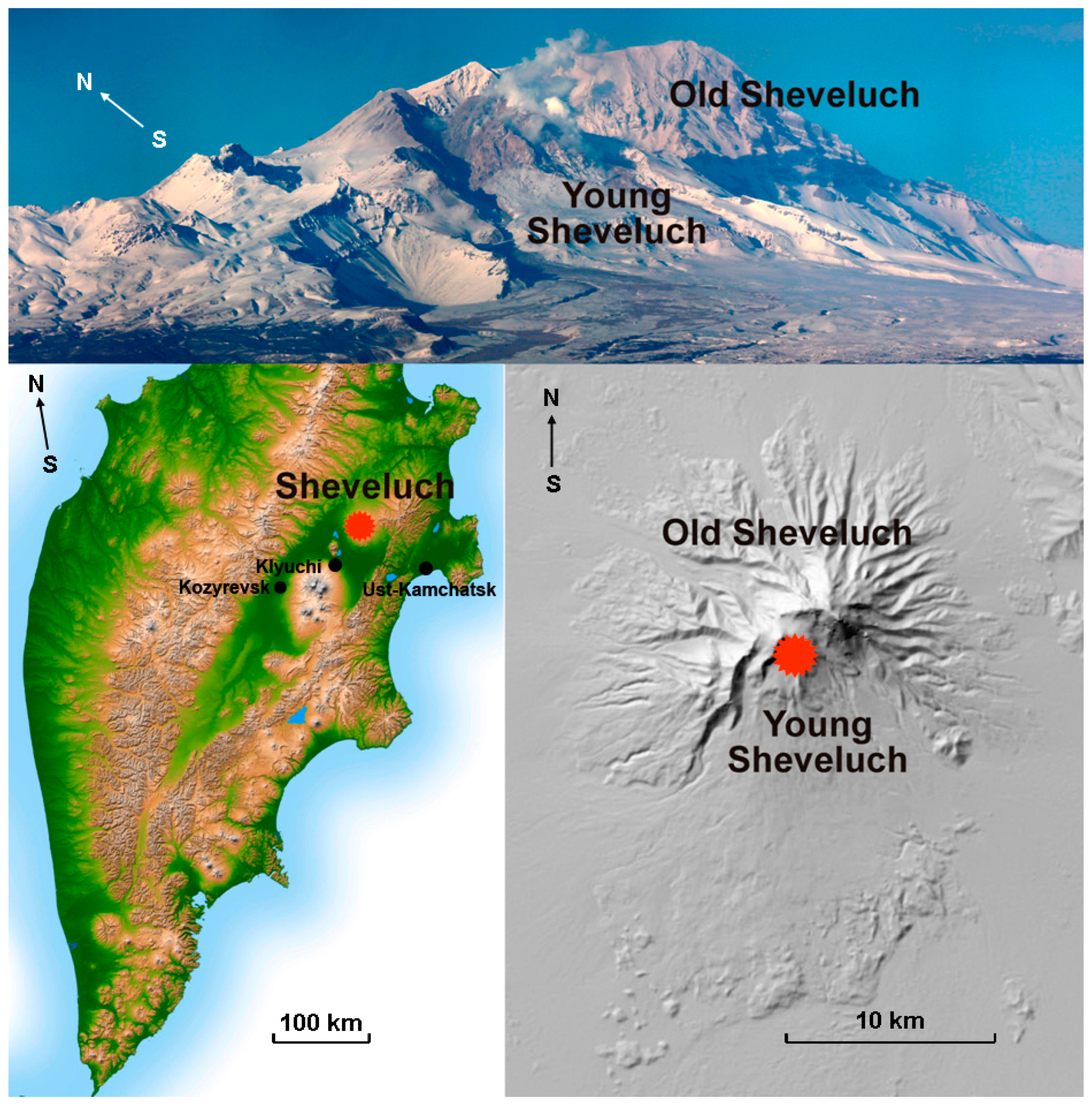
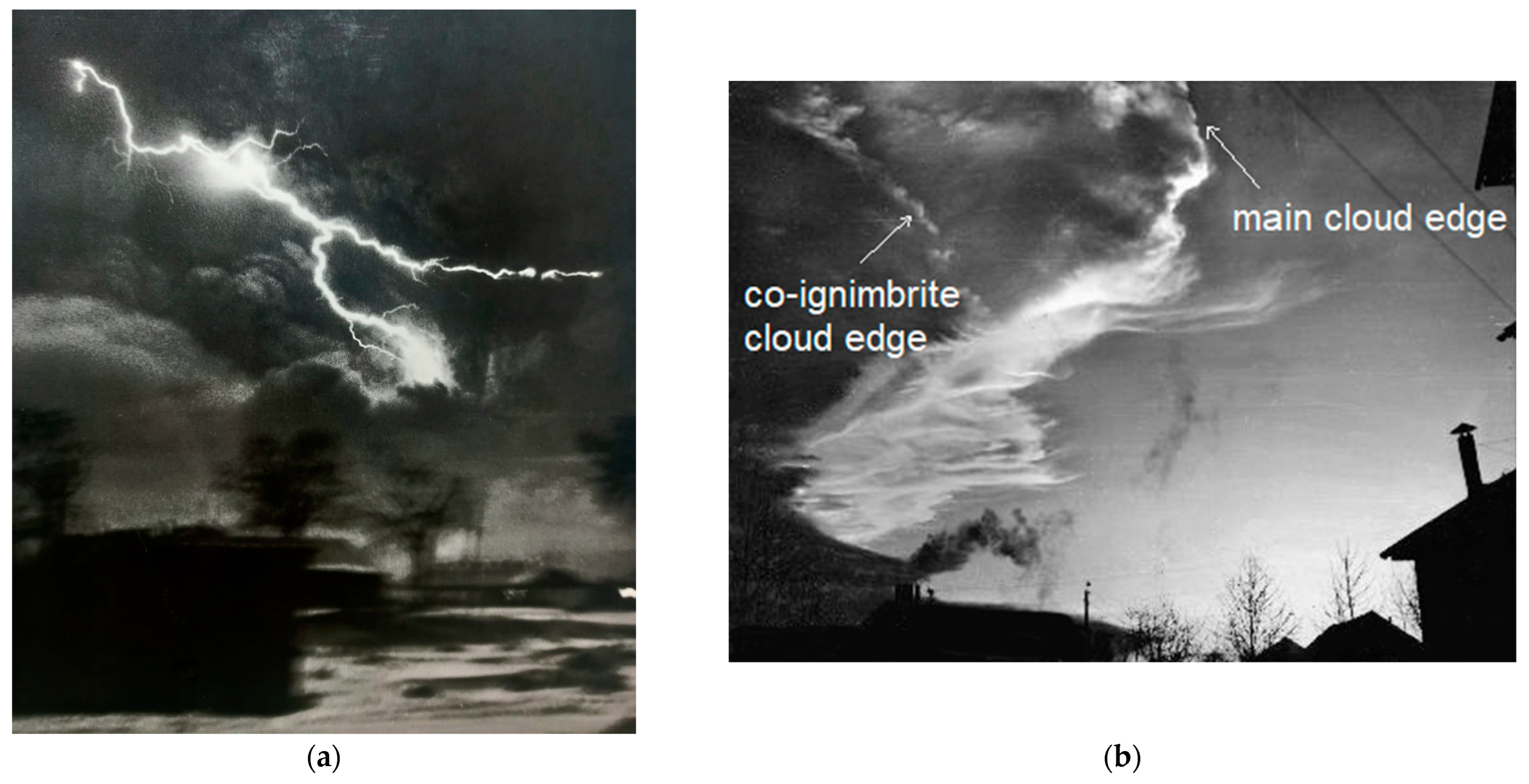
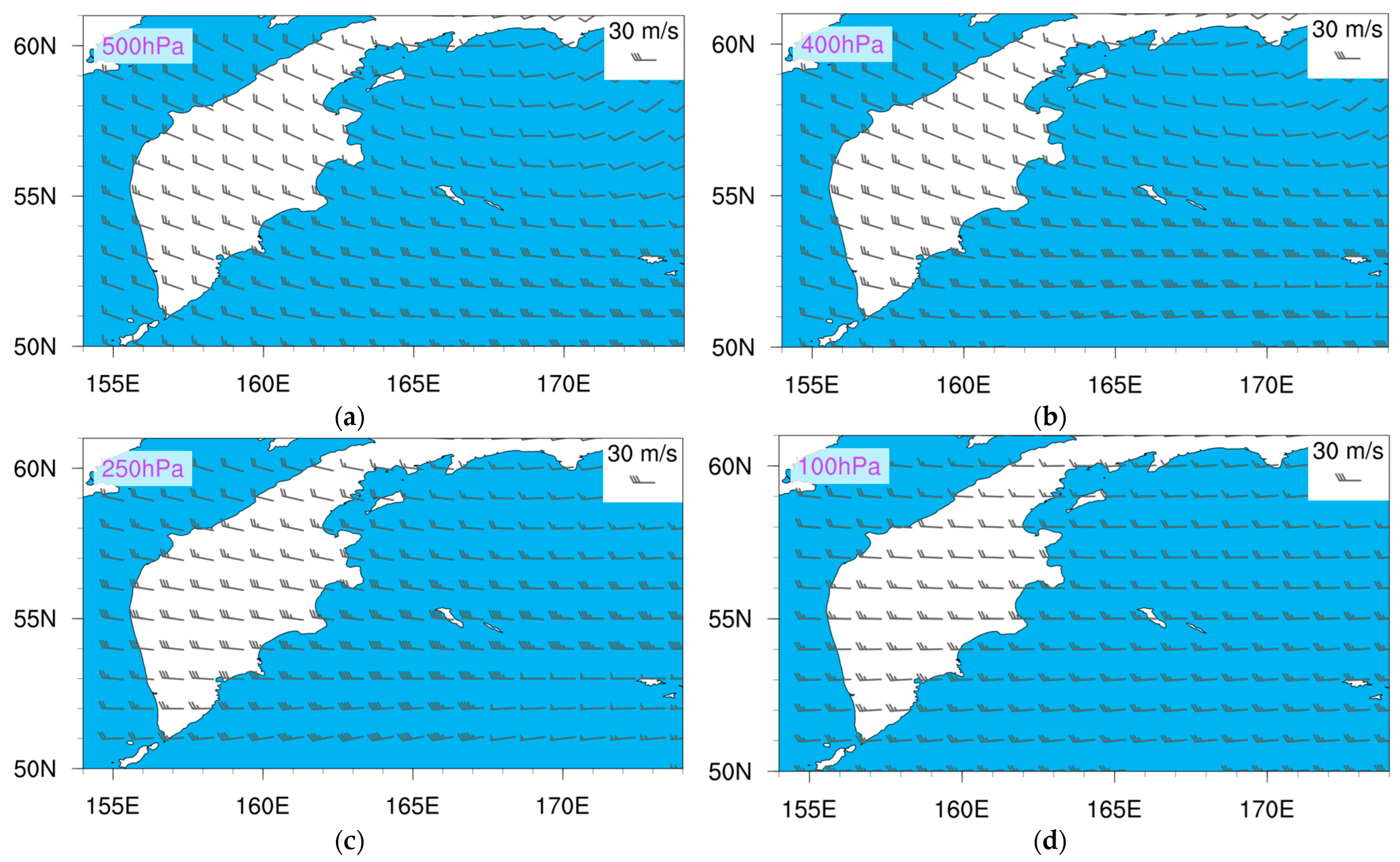
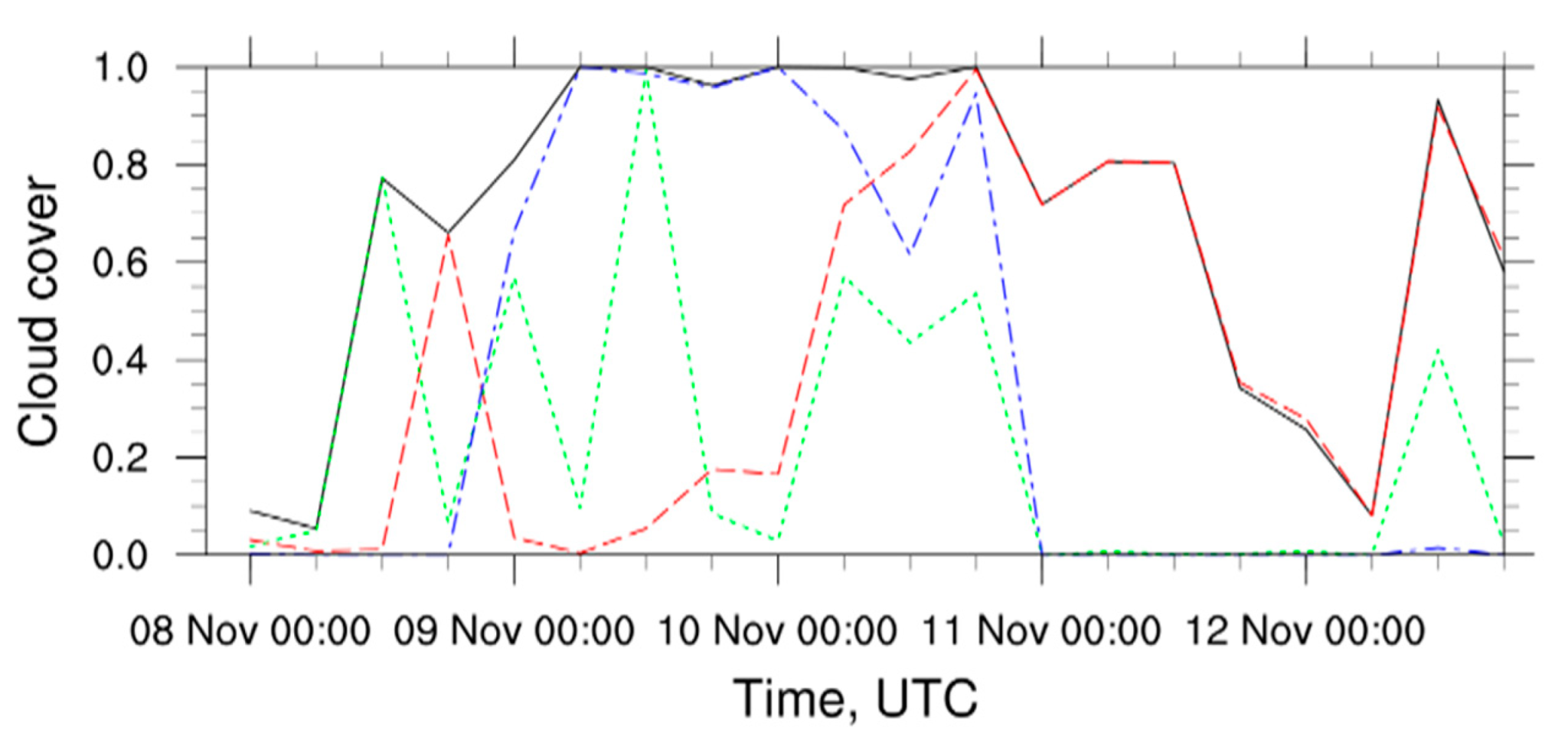
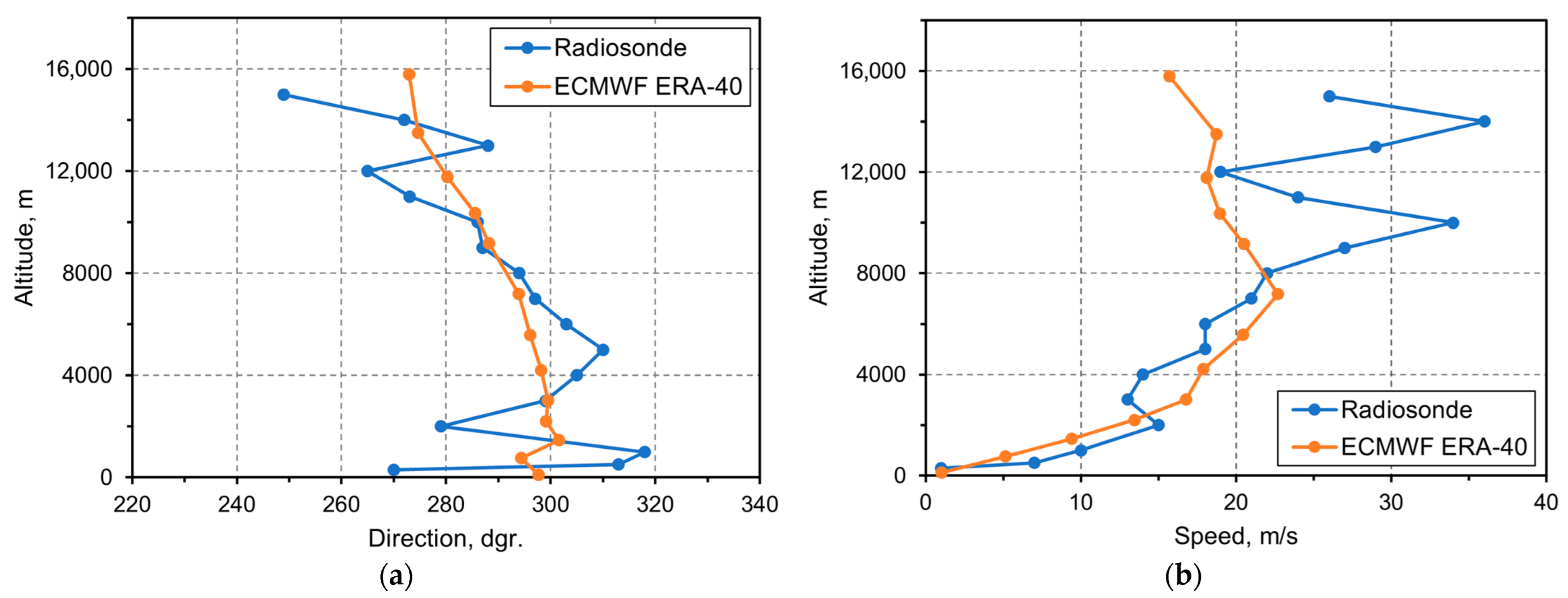
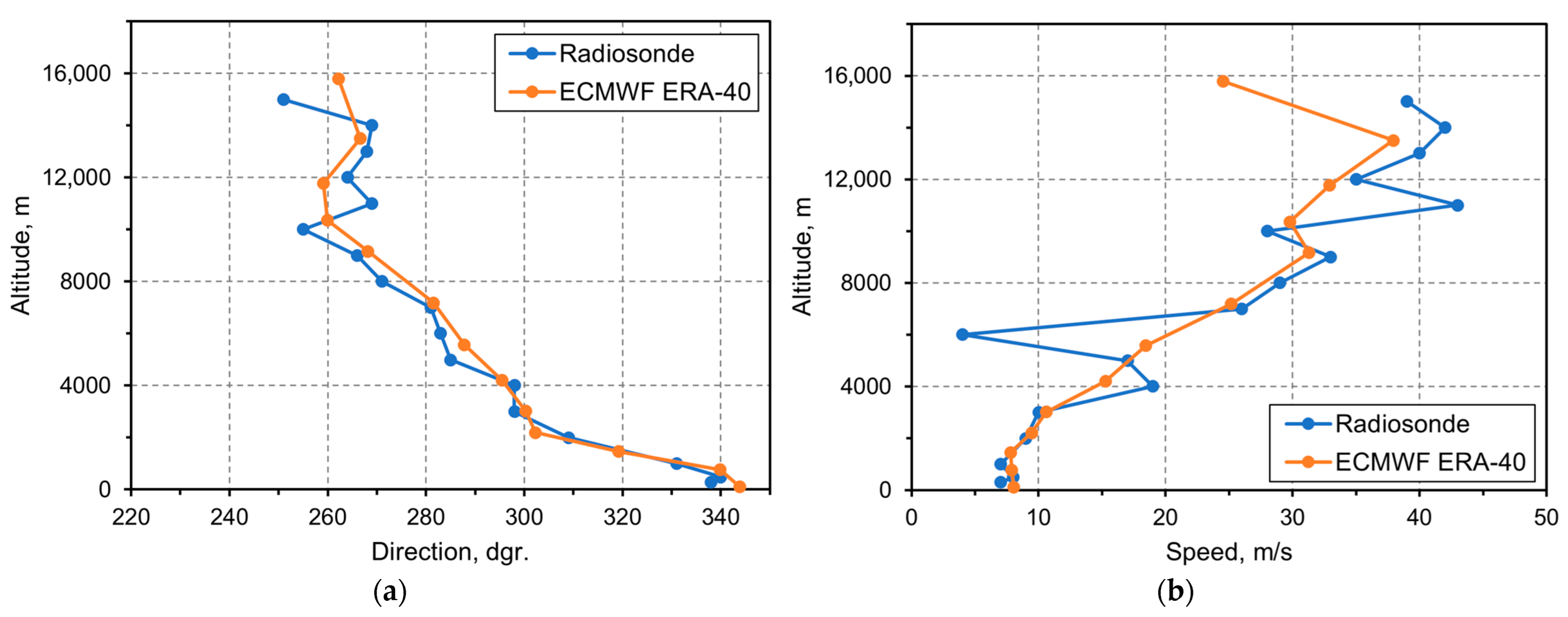
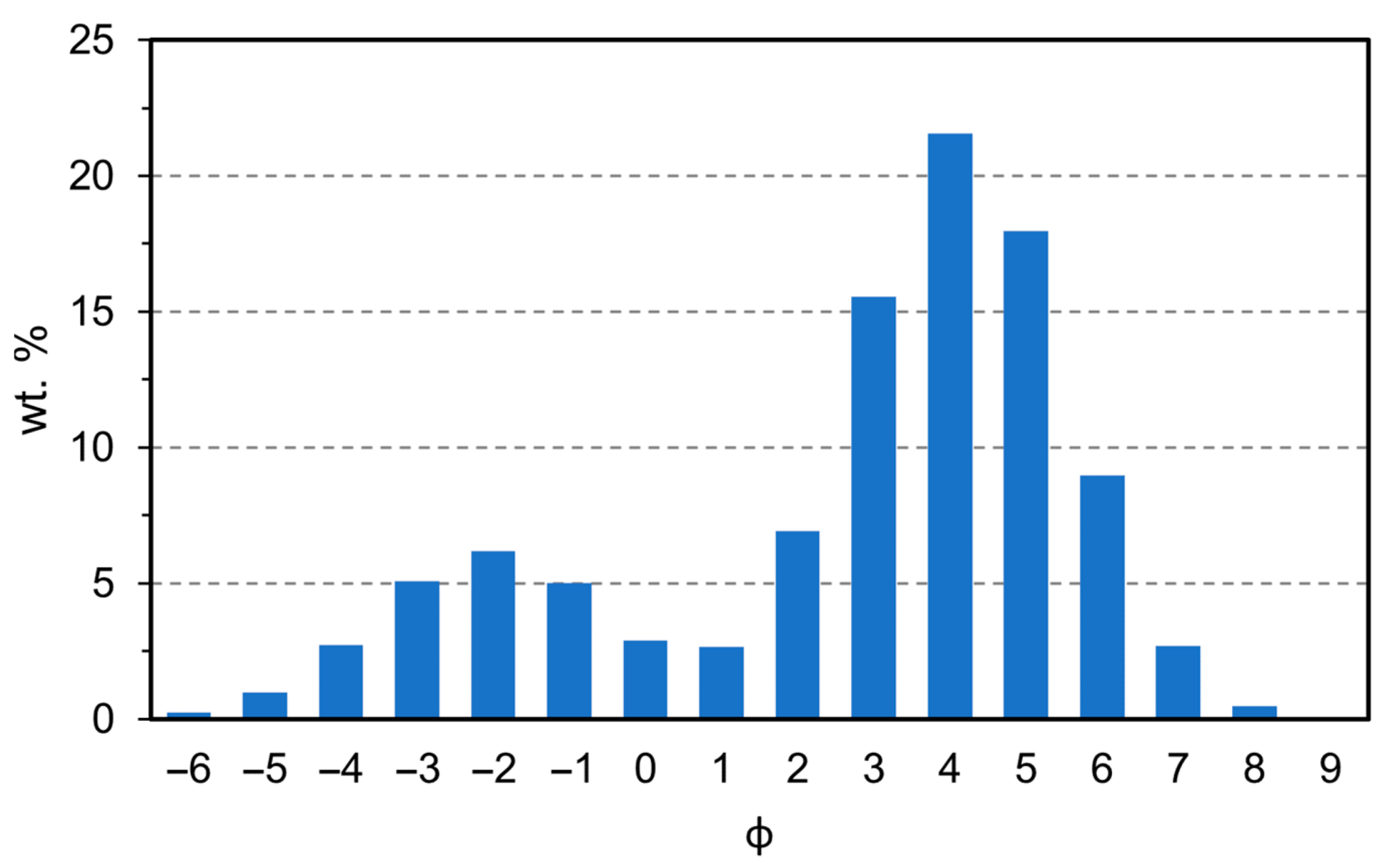

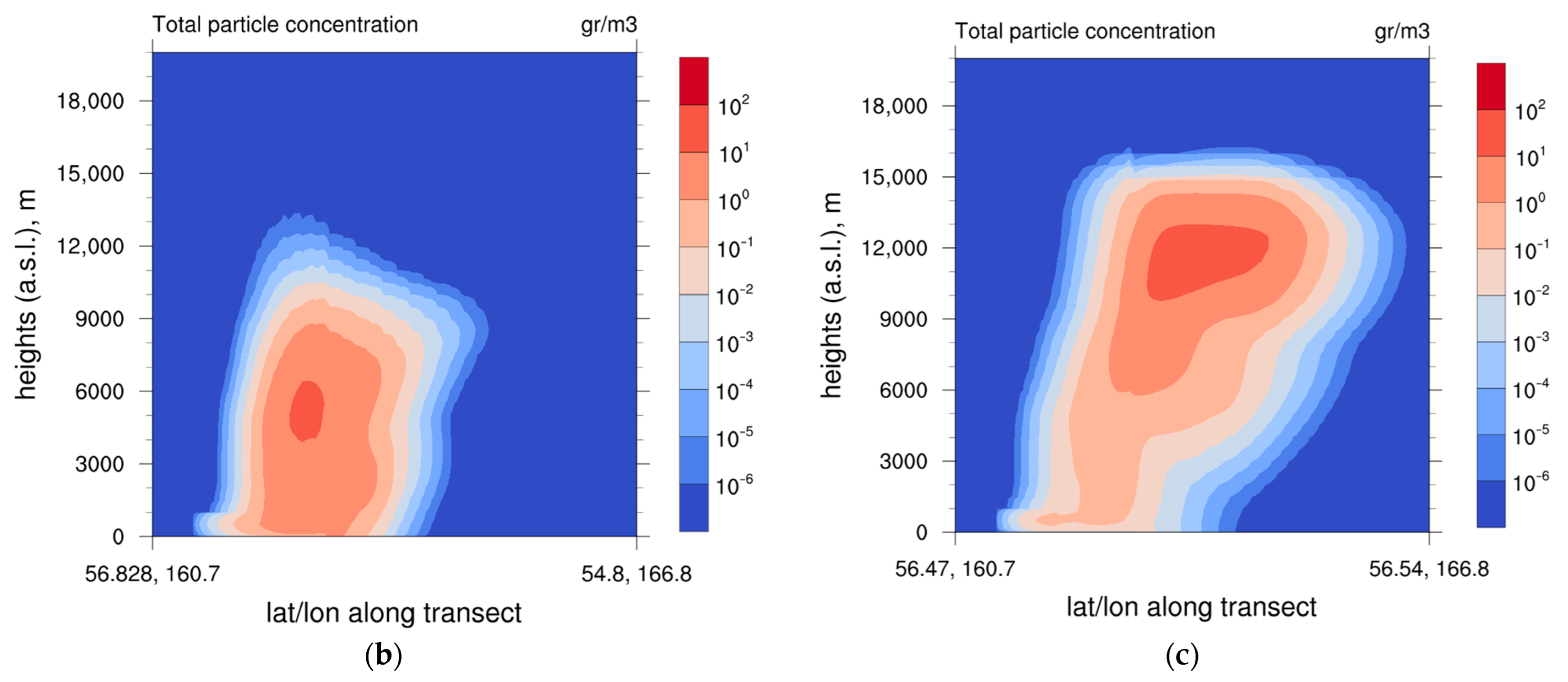

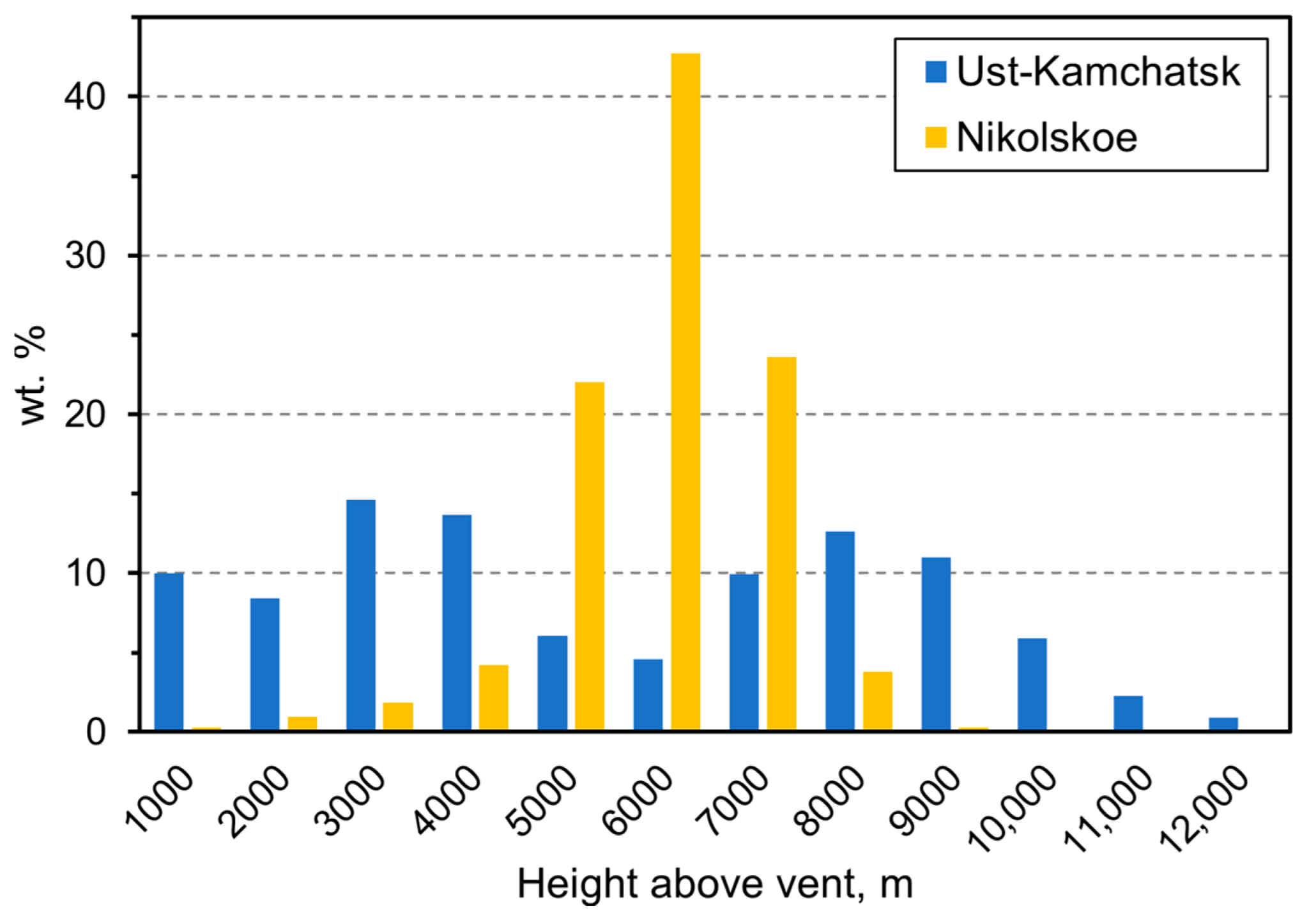

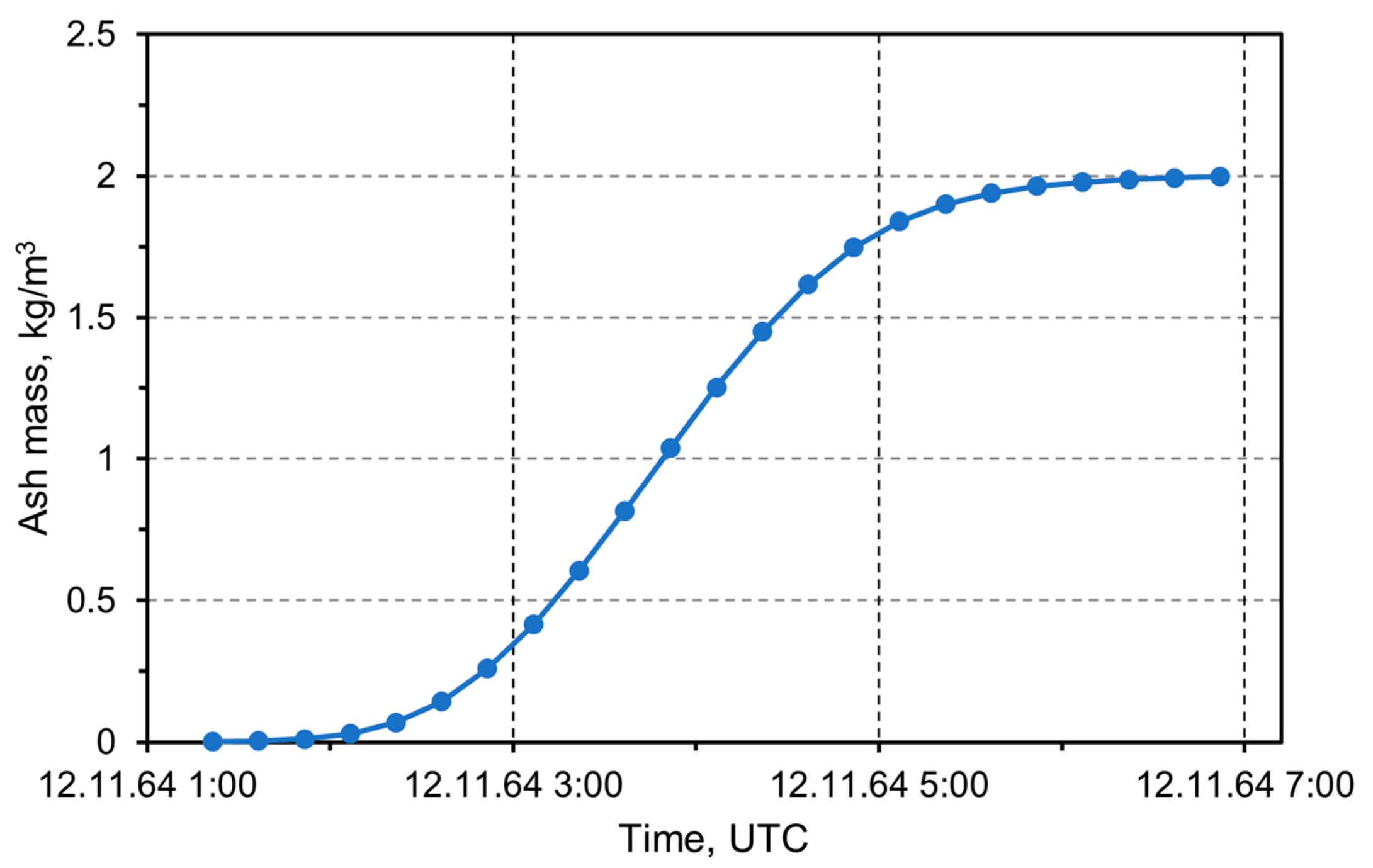
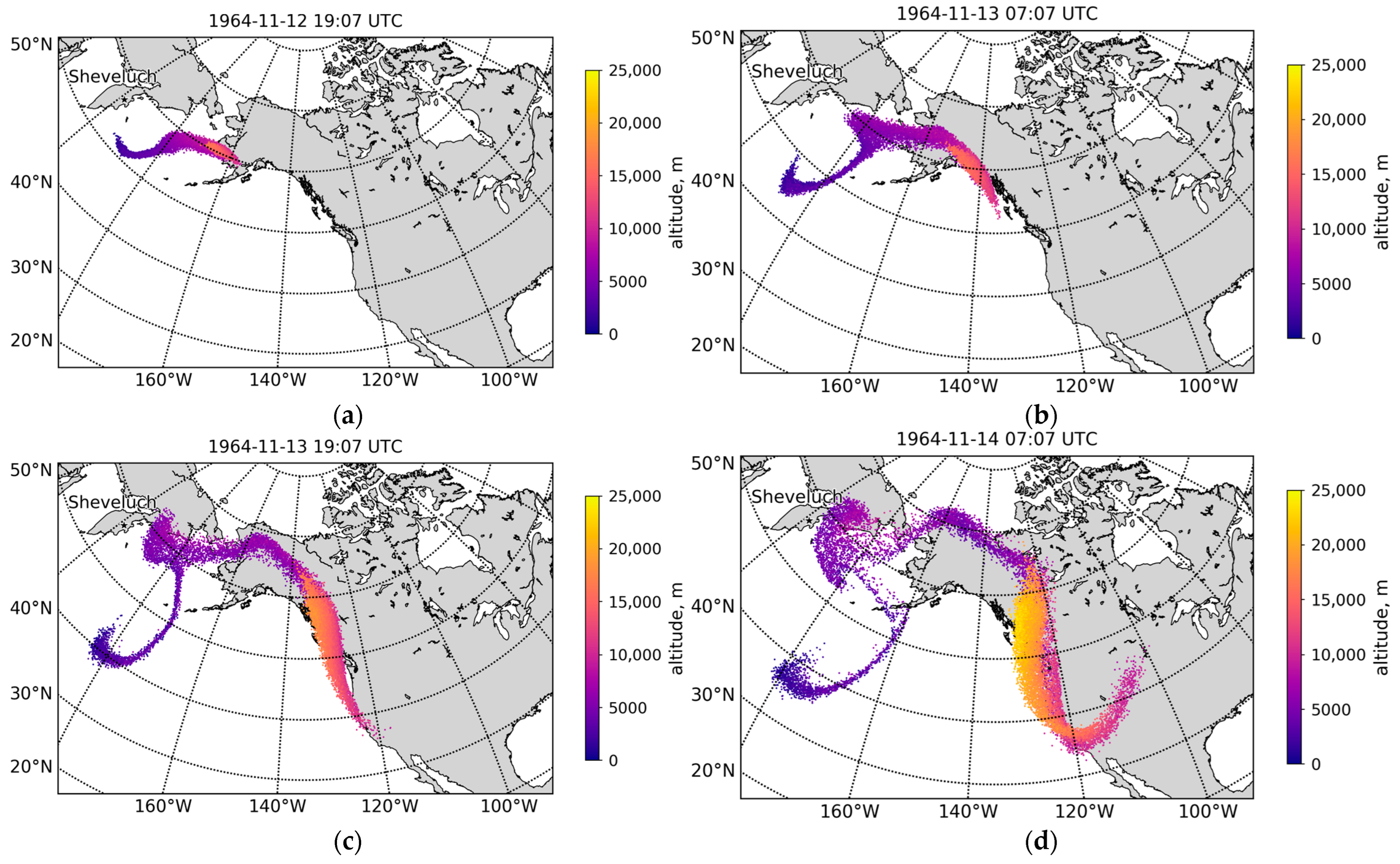
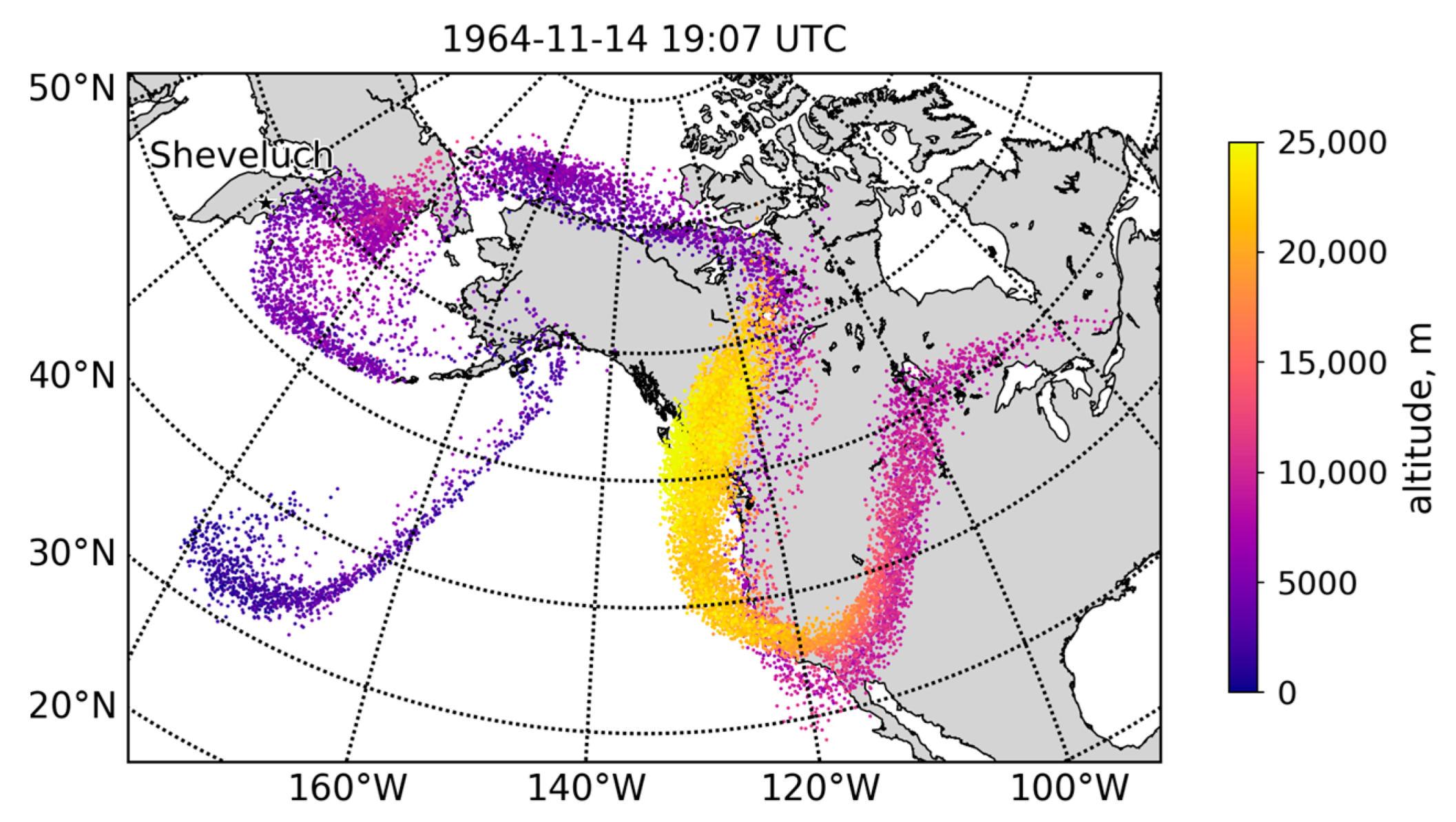

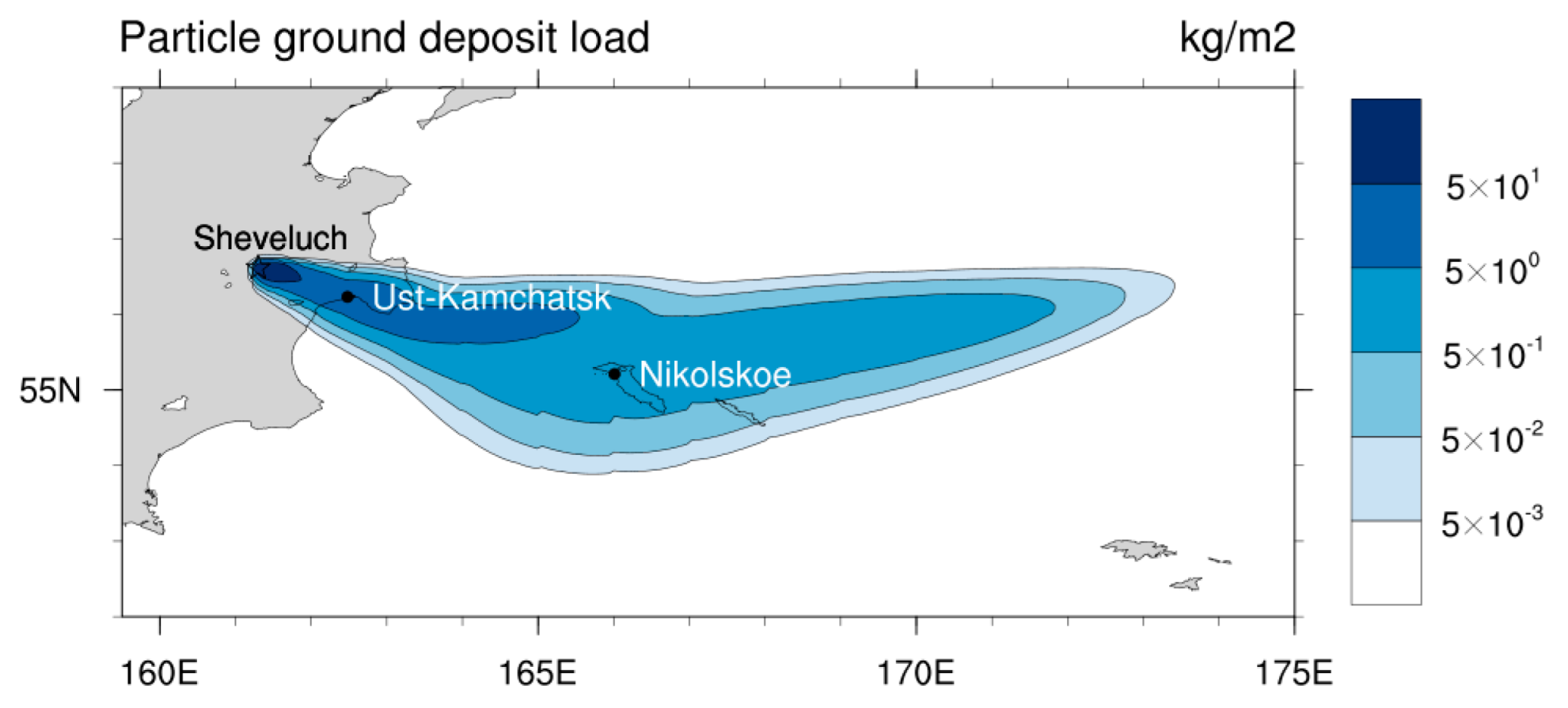
| Station ID | Locality | Coordinates |
|---|---|---|
| RSM00032389 | Klyuchi | 56.3167N, 160.8333E |
| RSM00032618 | Nikolskoe | 55.2000N, 165.9833E |
| RSM00032540 | Petropavlovsk-Kamchatsky | 53.0833N, 158.5833E |
| Height, m | 12.11.1964 17:30 UTC | 12.11.1964 5:30 UTC | ||
|---|---|---|---|---|
| Klyuchi, RSM00032389 | Nikolskoe, RSM00032618 | |||
| Direction, Deg. | Speed, m/s | Direction, Deg. | Speed, m/s | |
| 300 | 270 | 1 | 338 | 7 |
| 500 | 313 | 7 | 340 | 8 |
| 1000 | 318 | 10 | 331 | 7 |
| 2000 | 279 | 15 | 309 | 9 |
| 3000 | 299 | 13 | 298 | 10 |
| 4000 | 305 | 14 | 298 | 19 |
| 5000 | 310 | 18 | 285 | 17 |
| 6000 | 303 | 18 | 283 | 4 |
| 7000 | 297 | 21 | 281 | 26 |
| 8000 | 294 | 22 | 271 | 29 |
| 9000 | 287 | 27 | 266 | 33 |
| 10,000 | 286 | 34 | 255 | 28 |
| 11,000 | 273 | 24 | 269 | 43 |
| 12,000 | 265 | 19 | 264 | 35 |
| 13,000 | 288 | 29 | 268 | 40 |
| 14,000 | 272 | 36 | 269 | 42 |
| 15,000 | 249 | 26 | 251 | 39 |
| Parameter | Value |
|---|---|
| Domain size (deg) | 7 (lat) × 17 (lon) |
| Horizontal resolution (deg) | 0.056 (lat), 0.068 (lon) |
| Vertical resolution (m) | 500 |
| Bottom left corner of the calculation domain (lat; lon) | (52; 160) |
| Vent coordinates (lat; lon) | (56.633; 161.3) |
| Particle diameter (Φ-units) | −2–12 |
| Terminal settling velocity model | GANSER [59] |
| Model for vertical diffusion | SIMILARITY [22] |
| Model for horizontal diffusion | CMAQ [60] |
| Parameter | Value |
|---|---|
| Vent coordinates (lat; lon) | (56.633; 161.3) |
| Minimum cloud height (m) | 2500 |
| Maximum cloud height (m) | 15,000 |
| Vertical distribution of particles | linear |
| Particle size distribution | lognormal |
| Distribution parameters (Φ-units) | μ = 4.143; σ = 1.4 |
| Number of particles | 15,000 |
| Model for horizontal diffusion | turbulent |
| Vertical diffusion coefficient (m2/s) | 3.95 |
| Sedimentation physics | Reynolds |
| Particle Diameter (Φ-Units) | Particle Diameter (mm) | Mass Fraction (%) | ||
|---|---|---|---|---|
| Nizhnekamchatsk | Yar Cherny | Ust-Kamchatsk | ||
| >4 | <0.063 | 3 | 3.4 | 0.4 |
| 4–3 | 0.063–0.125 | 2.8 | 3 | 1.1 |
| 3–2 | 0.125–0.25 | 10.6 | 19.7 | 25.5 |
| 2–1 | 0.25–0.5 | 83.6 | 73.9 | 73 |
| 1–0 | 0.5–1.0 | - | - | - |
| Year\Month | I | II | III | IV | V | VI | VII | VIII | IX | X | XI | XII |
|---|---|---|---|---|---|---|---|---|---|---|---|---|
| 1963 | −1 | 3 | −2 | 2 | 2 | 2 | 2 | 1 | 0 | −1 | −2 | −10 |
| 1964 | −10 | −3 | −6 | −7 | −2 | −1 | −3 | −2 | −3 | −6 | −8 | −16 |
| 1965 | −15 | −7 | −11 | −5 | −2 | −3 | −3 | −2 | −5 | −2 | −9 | −12 |
| 1966 | −10 | −9 | −7 | −4 | −2 | −1 | 1 | 0 | −2 | −4 | −7 | −7 |
Publisher’s Note: MDPI stays neutral with regard to jurisdictional claims in published maps and institutional affiliations. |
© 2022 by the authors. Licensee MDPI, Basel, Switzerland. This article is an open access article distributed under the terms and conditions of the Creative Commons Attribution (CC BY) license (https://creativecommons.org/licenses/by/4.0/).
Share and Cite
Girina, O.; Malkovsky, S.; Sorokin, A.; Loupian, E.; Korolev, S. Numerical Modeling of the Ash Cloud Movement from the Catastrophic Eruption of the Sheveluch Volcano in November 1964. Remote Sens. 2022, 14, 3449. https://doi.org/10.3390/rs14143449
Girina O, Malkovsky S, Sorokin A, Loupian E, Korolev S. Numerical Modeling of the Ash Cloud Movement from the Catastrophic Eruption of the Sheveluch Volcano in November 1964. Remote Sensing. 2022; 14(14):3449. https://doi.org/10.3390/rs14143449
Chicago/Turabian StyleGirina, Olga, Sergey Malkovsky, Aleksei Sorokin, Evgeny Loupian, and Sergey Korolev. 2022. "Numerical Modeling of the Ash Cloud Movement from the Catastrophic Eruption of the Sheveluch Volcano in November 1964" Remote Sensing 14, no. 14: 3449. https://doi.org/10.3390/rs14143449







